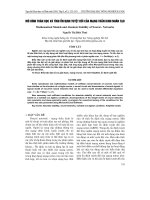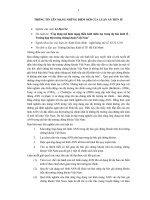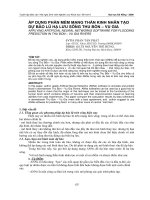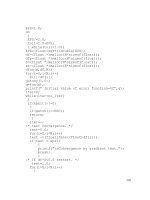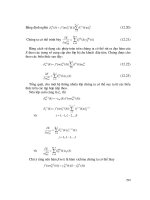Mạng thần kinh nhân tạo cho phân lớp màu sắc part 5 pps
Bạn đang xem bản rút gọn của tài liệu. Xem và tải ngay bản đầy đủ của tài liệu tại đây (273.73 KB, 11 trang )
299
Bằng định nghĩa
1
0
)2()2()1()1(
3
)())(()(
N
i
imimm
kknetfk
(12.20)
Chúng ta có thể trình bày
1
0
)0(
)1(
)1(
)()(
M
k
n
i
mn
kyk
E
(12.21)
Bằng cách sử dụng các phép toán trên chúng ta có thể rút ra đạo hàm của
E theo các trọng số cung cấp cho lớp bị che khuất đầu tiên. Chúng đợc cho
theo các biểu thức sau đây:
1
0
)1()1()0()0(
2
)())(()(
N
i
imimm
kknetfk
(12.22)
1
0
)0(
)0(
)()(
M
k
nm
mn
kxk
E
(12.23)
Tổng quát, cho một hệ thống nhiều lớp chúng ta có thể suy ra từ các biểu
thức trên các tập hợp tiếp theo.
Nếu lớp cuối cùng là L, thì
))(()()(
)()(
knetfkk
L
mm
L
m
và 0, ,2,1
)())(()(
)1(1
1
0
)()(
2
LLj
kknetfk
j
im
j
i
N
i
j
m
j
m
j
và
1
0
)0(
)0(
)()(
M
k
nm
mn
kxk
E
Chú ý rằng nếu hàm f(net) là hàm xichma chúng ta có thể thay
))(1)(())((
)()()(
kykyknetf
j
m
j
m
j
m
1, ,1,
)()(
1
0
)1()(
)(
LLj
kyk
E
M
k
j
n
j
m
j
mn
300
Tập hợp cuối cùng có thể dùng để phát triển một chơng trình C cho "đào
tạo" một mạng nhiều lớp. Nếu các đạo hàm đợc tính bằng cách đầu tiên
xem xét lớp ra và làm việc quay trở lại với lớp vào, phơng pháp tính các
đạo hàm này đợc gọi là phơng pháp lan truyền ngợc (Back-propagation).
Lan truyền ngợc cũng chỉ ra rằng sai lệch ở tín hiệu ra sẽ lan truyền trở lại
tới tín hiệu vào. Chơng trình dới đây dùng phơng pháp gradient kết hợp
kèm theo phơng pháp của Brent tìm kiếm tuyến tính để tập luyện cho một
hệ thống thần kinh với một số bất kỳ lớp ẩn và nút. Giải thuật thu gọn, mô tả
ở phần trớc cũng đợc sử dụng.
Chơng trình 12.3 PERNCONJG.C
/*Program 12.3 "PERNCONJG.C".
Training a multilayer neural network using the
conjugate gradient method.*/
/************************************
* Developed by M.A.Sid-Ahmed. *
* ver. 1.0, 1992. *
* @ 1994 *
*************************************/
/* Program for training a multi -layer perceptron
using the conjugate gradient method.*/
void conj_grad( float (*)(float *), void (*)(float
*, float *, int), float *, int, float, float, int);
float fun(float *);
void dfun(float *, float *,int)
#include <stdio.h>
#include <stdlib.h>
#include <math.h>
#include <conio.h>
#include<time.h>
#include <io.h>
int M,*NL,*NS,L;
int *d;
float *xp,*y,*net,*delta,theta;
301
void main()
{
float *w,q,xt;
int i,j,N,xd,ind,Nt;
char file_name[14],file_name2[14],ch;
FILE *fptr,*fptr2;
clrscr();
printf("\nDo you wish to use previously trained
weights? (y or n) >");
while(((ch=getch())!='y')&&(ch!='n'));
putch(ch);
switch(ch)
{
case 'y' :
printf("\nEnter file name >");
scanf("%s",file_name);
fptr=fopen(file_name,"r");
if(fptr==NULL)
{
printf("No such file exists.");
exit(1);
}
fscanf(fptr,"%d ",&L);
NL=(int *)malloc(L*sizeof(int));
NS=(int *)malloc(L-2)*sizeof(int);
for(i=0;i<L;i++)
fscanf(fptr,"%d ",&NL[i]);
NS[0]=NL[0]*NL[1];
for(i=1;i<(L-2);i++)
NS[i]=NS[i-1]+NL[i]*NL[i+1];
N=NS[L-3]+NL[L-2]*NL[L-1]; /* Total # of
weights */
/* Assigning memory for weights. */
w=(float *)malloc(N*sizeof(float));
for(i=0;i<N;i++)
fscanf(fptr,"%f ", &w[i]);
fscanf(fptr,"%f ",&theta);
302
fclose(fptr);
break;
case 'n':
/* Entering number of layers. */
printf("\nEnter number of hidden layers >");
scanf("%d",&L);
L+=2; /*adding input and output layers. */
NL=(int *)malloc(L*sizeof(int));
NS=(int *)malloc((L-2)*sizeof(int));
printf("Enter number of nodes in input layer >");
scanf("%d",&NL[0]);
for(i=1;i<=(L-2);i++)
{
printf("Enter number of nodes in hidden layer %d
>",i);
scanf("%d",&NL[i]);
}
printf("Enter number of nodes in output layer >");
scanf("%d",&NL[L-1]);
NS[0]=NL[0]*NL[1];
for(i=1;i<(L-2);i++)
NS[i]=NS[i-1]+NL[i]*NL[i+1];
N=NS[L-3]+NL[L-2]*NL[L-1]; /* Total # of weights.
*/
/* Assigning memory for weights. */
w=(float *)malloc(N*sizeof(float));
randomize();
for(i=0;i<N;i++)
w[i]=(float)random(N)/(float)N;
theta=0.1;
}
Nt=0;
for (i=1; i<L; i++)
Nt+=NL[i]; /* Total number of neurals.
*/
gotoxy(1,10);
printf("Enter file name for storing trained
weights > ");
303
scanf ( "%s" , file_name) ;
ind=access(file_name,0);
while(!ind)
{
gotoxy(1,12);
printf("File exists. Wish to overwrite? (y or
n) >");
while(((ch=getch())!='y')&&(ch!='n'));
putch(ch);
switch(ch)
{
case 'y':
ind=1;
break;
case 'n' :
gotoxy(1,7);
printf(" ");
gotoxy (1,10);
printf ( " ");
gotoxy(1,100);
printf("Enter file name >");
scanf("%s",file_name);
ind=access(file_name,0);
}
}
fptr=fopen(file_name,"w");
/* Assigning memory to *net, *z, *delta. */
net=(float *)malloc(Nt*sizeof(float));
y=(float *)malloc(Nt*sizeof(float));
delta=(float *)malloc(Nt*sizeof(float));
printf("\nEnter file - name containing training
data >");
scanf("%s",file_name2);
fptr2=fopen(file_name2,"r");
if(fptr2==NULL)
{
printf("file %s does not exist. ", file_name);
exit(1);
}
304
/* Determining the size of the data.*/
M=0; ind=1;
while(1)
{
for(i=0;i<NL[0];i++)
{
if((fscanf(fptr2,"%f ",&xt))==EOF) /*input
data. */
{ ind=0;
break;
}
}
if(ind==0)
break;
for(i=0;i<NL[L-1];i++) /* desired output. */
fscanf(fptr2,"%d ",&xd);
M++;
}
printf("\n# of data points=%d",M);
rewind(fptr2);
/* Assigning memory to *xp, *d */
xp=(float *)malloc((M*NL[0])*sizeof(float));
d=(int *)malloc((M*NL[L-1])*sizeof(int));
/* Reading in the data. */
for(i=0; i<M; i++)
{
for(j=0;j<NL[0];j++)
fscanf(fptr2,"%f ",&xp[j*M+i]);
for(j=0;j<NL[L-1];j++)
fscanf(fptr2,"%d ",&d[j*M+i]);
}
fclose(fptr2);
/*Call the Fletcher-Reeves conj. grad. algorithm.*/
clrscr();
gotoxy(1, 1);
printf("Press ESC to exit and save latest update
for weights.");
conj_grad(fun, dfun, w, N, 1.e-3,1.e-3, 10000);
fprintf(fptr, "%d", L);
for( i=0; i<L; i++)
305
fprintf(fptr , "%d ", NL[i]);
for(i=0; i<N; i++)
fprintf(fptr,"%f ",w[i]);
fprintf(fptr, "%f ", theta);
fclose(fptr);
q=fun(w);
printf("\nError=%f ", q);
printf ( "\n File name used to store weights i s
%s" , file_name);
printf ( "\n File name for the trai ning data is
%s" , file_name2);
}
extern float *net, *w, *delta, *y ;
extern int *d;
extern int *NS,*NL;
/* Generating the function. */
float fun(float *w)
{
int i,j,k,m,n,Nt1,Nt2;
float q, error, E;
q=0.0;
for(k=0; k<M; k++)
{
for(i=0;i<NL[1];i++) /* From input layer to
first */
{ /* hidden layer.
*/
net[i]=0.0;
for(j=0;j<NL[0];j++)
net[i]+=w[i+j*NL[1]]*xp[j*M+k];
net[i]+=theta;
E=(float)exp(-(double)net[i]);
y[i]=1.0/(1.0+E);
}
Nt1=NL[1]; Nt2=0;
for(n=2;n<L;n++) /* From layer n-1 to layer
n. */
306
{
for(i=0;i<NL[n];i++)
{
m=Nt1+i;
net[m]=0.0;
for(j=0;j<NL[n-1];j++)
net[m]+=w[NS[n-2]+i+j*NL[n]]*y[j+Nt2];
net[m]+=theta;
E=(float)exp(-(double)net[m]);
y[m]=1.0/(1.0+E);
}
Nt1+=NL[n];
Nt2+=NL[n-1];
}
for(i=0;i<NL[L-1];i++) /* Caculating
the error. */
{
error=d[k+i*M]-y[Nt2+i];
q+=error*error;
}
} /*k-loop*/
q/=2 ;
return q;
}
extern float *df,*w,*net;
extern *NL,*NL;
#define fd(i) y[i]*(1.0-y[i]) /* Define
derivative. */
void dfun(float *w, float *df, int N)
{
int i,j,k,m,n,Nt1,Nt2,Nt3,ii;
float E,error,sum;
/* Initialize derivative vector. */
for(i=0;i<N;i++)
df[i]=0.0;
307
/* Start. */
for(k=0;k<M;k++)
{
/* Forward propagation. */
for(i=0;i<NL[1];i++) /* From input layer to
first */
{ /* hidden layer. */
net[i]=0.0;
for(j=0;j<NL[0];j++)
net[i]+=w[i+j*NL[1]]*xp[j*M+k];
net[i]+=theta;
E=(float)exp(-(double)net[i]);
y[i]=1.0/(1.0+E);
}
Nt1=NL[1]; Nt2=0;
for(n=2;n<L;n++) /*From layer n-1 to layer n. */
{
for(i=0;i<NL[n];i++)
{
m=Nt1+i;
net[m]=0.0;
for(j=0;j<NL[n-1];j++)
net[m]+=w[NS[n-2]+i+j*NL[n]]*y[j+Nt2];
net[m]+=theta;
E=(float)exp(-(double)net[m]);
y[m]=1.0/(1.0+E);
}
Nt1+=NL[n];
Nt2+=NL[n-1];
}
Nt1=0;
for(i=1; i<(L-1);i++)
Nt1+=NL[i];
for(i=0; i<NL[L-1]; i++) /* delta's for output
layer. */
{
ii=Nt1+i;
error=d[k+i*M]-y[ii];
delta[ii]=-error*fd(ii);
308
}
for(m=0;m<(L-2);m++) /* delta's by back
propagation. */
{
Nt2=Nt1-NL[L-2-m];
for(i=0;i<NL[L-2-m];i++)
{
ii=Nt2+i ;
sum=0.0;
for(j=0;j<NL[L-1-m];j++)
sum+=delta[Nt1+j]*w[NS[L-3-m]+j+i*NL[L-1-
m]];
delta[ii]=fd(ii)*sum;
}
Nt1=Nt2;
}
for(i=0;i<NL[1];i++)
for(j=0;j<NL[0];j++)
df[i+j*NL[1]]+=delta[i]*xp[k+j*M];
Nt1=NS[0]; Nt2=0;
Nt3=NL[1];
for(m=1;m<(L-1) ;m++)
{
for(i=0;i<NL[m+1];i++)
for(j=0;j<NL[m];j++)
df[Nt1+i+j*NL[m+1]]+=delta[Nt3+i]*y[Nt2+j];
Nt1=NS[m] ;
Nt2+=NL[m];
Nt3+=NL[m+1];
}
} /*k-loop*/
}
#include <stdio.h>
#include <stdlib.h>
#include <math.h>
#include <conio.h>
void conj_grad( float (*)(float *), void(*)(float
*, float*,
309
int), float *, int, float ,float, int );
float f( float, float (*)(float *),float *, float
*,
float *, int);
float fun(float *);
void dfun(float*, float*,int);
void bracket(float , float ,
float *,float *,float (*)(float *),
float *, float *, float *, int);
float Brent(float, float, float (*)(float *),float,
float *,float *, float *, int );
/* Conjugate gradient method.
fun:is a subprogram that returns the value
of the function to be minimized. The
arguments are: vector of variables, number
of variables.
dfun:is subprogram that provides the gradients.
Arguments:
variables, gradients, number of variables.
x[]: contain the variables. An initial value
need to be
supplied.
N: number of variables.
eps1: overall convergence criteria.
eps2: line search convergence criteria.
no_iter: Maximum number of iterations. */
#define ESC 0x1B
float EPS; /*square-root of machine epsilon. */
void conj_grad( float (*fun)(float *), void
(*dfun)(float *, float
*, int), float *x, int N, float eps1, float
eps2, int no_iter)
{
float *df,*dfp,*xt,*S,q,astar,sum,test,sum1,sum2;
int i,j,iter;
float a,b,tol1;
